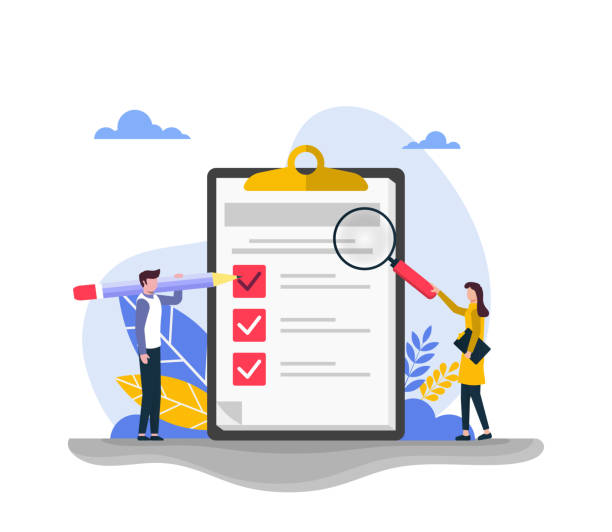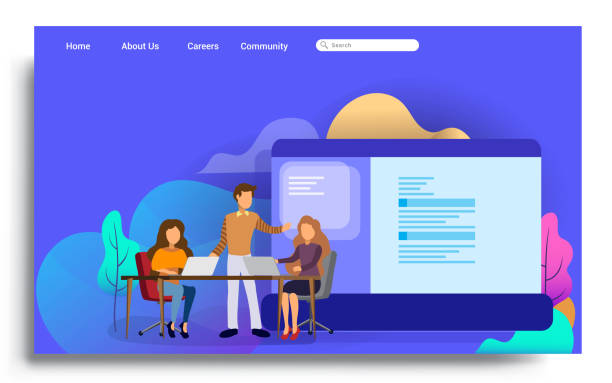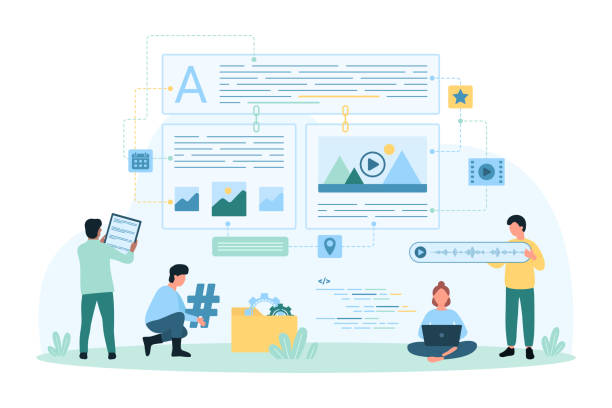Introduction to Secure Website Design: Why is it Essential?

In today’s digital world, where online interactions have become an inseparable part of daily life, secure website design is no longer an option, but an undeniable necessity.
#CyberSecurity #DataProtection #UserTrust.
With the relentless increase in cyber threats, from phishing attacks to database breaches, every website, regardless of its size or type of activity, is at risk.
The main goal of secure website design is to protect sensitive user information, maintain data integrity, and ensure the continuous accessibility of online services.
This not only helps your business’s credibility but also prevents financial and legal losses resulting from security breaches.
An insecure website can lead to loss of customer trust, heavy fines, and even complete business failure.
Therefore, understanding its principles and proper implementation is the cornerstone of any successful online presence.
This educational guide will help you become familiar with various aspects of web security and take the necessary steps to protect your digital assets.
Remember, website security is an ongoing process, not a one-time event.
Did you know that poor online store design can drive away up to 70% of your potential customers? Rasaweb transforms your sales with professional and user-friendly e-commerce website design.
✅ Significant increase in sales and revenue
✅ Full optimization for search engines and mobile devices
⚡ [Get free consultation from Rasaweb]
Common Website Vulnerabilities and How to Identify Them

To achieve secure website design, you must first know your enemy.
Many cyberattacks occur through known vulnerabilities found in website coding, server configuration, or software.
#CyberAttacks #Vulnerabilities #SoftwareSecurity.
Among the most common vulnerabilities is SQL Injection, which allows an attacker to gain access to the database by inserting malicious code into input fields.
Cross-Site Scripting (XSS) attacks also allow attackers to inject malicious code into web pages and steal user information.
Weaknesses in Session Management and authentication are also issues that can grant attackers unauthorized access to user accounts.
Furthermore, incorrect server configurations, the use of outdated components, and irregular software updates open doors for attackers.
Identifying these vulnerabilities is usually done through Penetration Testing and Vulnerability Scanners.
These specialized processes help identify weaknesses before they are discovered and exploited by attackers.
A deep understanding of these threats is the first step towards a secure website and allows you to adopt appropriate defense strategies.
Basic Security Measures for Your Website

The foundations of secure website design are built upon a set of basic security measures that must be considered from the very beginning.
#SSLCertificate #StrongPassword #Updates.
The first step is implementing an SSL/TLS certificate, which prevents eavesdropping and tampering with information by encrypting data sent between the user and the server.
This is especially vital for websites that collect sensitive information such as credit card details or personal data.
The second measure is promoting the use of strong and unique passwords for website users and administrators.
Two-Factor Authentication (2FA) is also highly recommended.
Furthermore, regular updates of all software used, including the Content Management System (CMS), plugins, themes, and the server, are of paramount importance.
Attackers often exploit vulnerabilities in older software versions for intrusion.
Maintaining regular and encrypted backups of your website and database is also a vital guideline so that in case of any security issue, you can quickly restore your website.
These basic measures form the backbone of your website security, and without them, any other efforts to enhance security will be insufficient.
| Security Measure | Description | Key Benefits |
|---|---|---|
| Use of SSL/TLS | Encrypts communication between browser and server | Increases user trust, improves SEO, data protection |
| Strong Password and 2FA | Using complex passwords and two-factor authentication | Prevents unauthorized access to user accounts |
| Regular Updates | Updating CMS, plugins, themes, and server | Fixes known vulnerabilities, improves performance |
| Regular Backups | Creating backups of website and database | Enables quick recovery after a security incident |
Database Security: The Backbone of Secure Website Design

The heart of every website is its database, which contains vital user information, content, and settings.
Therefore, secure website design would be incomplete without special attention to database security.
#DataEncryption #AccessControl #InformationProtection.
One of the most important measures in this regard is the encryption of sensitive data.
Information such as passwords, credit card numbers, and identity data must be encrypted before being stored in the database.
Using strong and up-to-date encryption algorithms for this purpose is essential.
Furthermore, strict access control policies must be enforced; meaning only users and applications with an urgent need for access to specific data should be granted permission.
Never use default credentials for the database, and ensure that database login information is not directly visible in the code.
Database firewalls and Intrusion Detection Systems (IDS) can also provide an additional layer of security.
Input Sanitization and the use of Prepared Statements in SQL queries prevent SQL injection attacks, which is a technical and highly important aspect of database security.
A secure website must adhere to these principles to prevent information leakage.
Are you tired of losing business opportunities due to not having a professional corporate website?
Rasaweb helps you with professional corporate website design to:
✅ Build a powerful and reliable image for your brand
✅ Convert website visitors into loyal customers
⚡ Get a free consultation now!
Best Secure Coding Practices for Developers

An inseparable part of secure website design is secure coding.
Web developers play a key role in building websites resilient to attacks.
#InputValidation #SecureCoding #ErrorHandling.
One of the fundamental principles is Input Validation.
All data entered by users into the website, without exception, must be validated and sanitized to prevent the entry of malicious code or unauthorized data.
This includes validating data type, length, format, and content.
The second principle is proper Error Handling.
Error information should not disclose too many details about the website’s internal structure (such as file paths, database type, or usernames), as this information can be exploited by attackers.
General and user-friendly error messages are sufficient.
Using Prepared Statements to prevent SQL injection attacks, avoiding insecure and deprecated functions, and utilizing web development frameworks that incorporate security principles are other expert recommendations.
Additionally, the Principle of Least Privilege should be observed in coding; meaning each part of the code should only have access to resources that are essential for its operation.
These guideline approaches help developers build a secure website from the ground up.
Server and Hosting Security: Choosing a Reliable Host

In addition to coding and the database, the environment in which your website resides, namely the server and hosting service, plays a pivotal role in secure website design.
#SecureHosting #Firewall #ServerConfiguration.
Choosing a reputable and well-known hosting provider that prioritizes security is the first step.
These providers typically offer measures such as DDoS protection, powerful firewalls, regular malware scans, and 24/7 technical support.
However, your responsibility does not end there.
You must ensure that your server is correctly configured.
This includes disabling unnecessary ports and services, changing default ports, and using secure protocols like SFTP instead of FTP.
Regular updates of the server’s operating system and the installation of security patches are also crucial for server security.
Using Web Application Firewalls (WAFs) can provide an additional layer of defense against common web attacks such as XSS and SQL Injection.
Website security largely depends on the security of its infrastructure.
This is an explanatory and very important aspect that should be considered when planning for secure website design.
An insecure server can nullify all your efforts to secure the code.
Continuous Monitoring and Incident Response

Even with the best secure website design approaches, the possibility of security incidents is not completely eliminated.
Therefore, having a comprehensive strategy for continuous monitoring and rapid incident response is essential.
#SecurityMonitoring #IncidentResponse #LogAnalysis.
Using Security Information and Event Management (SIEM) systems can help you collect and analyze security logs from various sources and identify suspicious activities.
Vulnerability scanning tools and periodic penetration tests should also be run regularly to discover new weaknesses.
Most importantly, having a predefined Incident Response Plan is crucial.
This plan should include steps for identification, containment, eradication, recovery, and lessons learned from the incident.
The responsible team must be trained, and roles and responsibilities clearly defined.
Monitoring unusual user behavior and network traffic can also reveal early signs of intrusion.
This informative and analytical section teaches you how to protect your data and react quickly and efficiently if a problem arises.
Without an active monitoring system and a robust response plan, even secure websites will remain vulnerable to new threats.
| Incident Response Phase | Description |
|---|---|
| Preparation | Developing policies, training personnel, procuring tools |
| Identification | Detecting the occurrence of a security incident and collecting evidence |
| Containment | Limiting the scope of damage and preventing attack propagation |
| Eradication | Removing the root cause of intrusion and vulnerabilities |
| Recovery | Restoring systems and data to a normal and secure state |
| Lessons Learned | Reviewing the incident, identifying weaknesses, and improving processes |
The Role of User Awareness in Enhancing Website Security

In the discussion of secure website design, the focus is often on technical and coding aspects, but the human factor is equally important.
#UserAwareness #SecurityTraining #SocialEngineering.
Many successful cyberattacks target users through social engineering and phishing, rather than the systems themselves.
Educating and guiding users and employees on best security practices can significantly increase the overall security level of a website.
These trainings should include topics such as recognizing phishing emails, the importance of using strong and unique passwords, avoiding clicking on suspicious links, and vigilance against unusual requests for personal information.
Your website might be technically very strong, but if one of its users or administrators falls victim to a phishing attack, all efforts in website security are jeopardized.
Creating a culture of security within the organization and among users, through regular and educational communication, not only helps protect the website but also keeps users’ personal information secure.
This explanatory and comprehensive approach is a vital part of the overall strategy for web design with a security approach that should not be overlooked.
Are you tired of your e-commerce website not generating as much revenue as it could for you? Rasaweb, specializing in professional e-commerce website design, solves this problem permanently!
✅ Increase sales rate and revenue
✅ High loading speed and unparalleled user experience
⚡ Get a free e-commerce website design consultation
Compliance with Security Laws and Regulations and the Future of Web Security

In the information age, secure website design is not limited to technical issues; it also includes compliance with international and local laws and regulations.
#DataSecurityLaws #GDPR #FutureOfSecurity.
Regulations such as GDPR (General Data Protection Regulation) in Europe, CCPA (California Consumer Privacy Act) in the United States, and PCI DSS (Payment Card Industry Data Security Standard) are mandatory for websites that process credit card information.
Non-compliance with these regulations can lead to heavy fines and loss of credibility.
This analytical and thought-provoking content explores how websites must align themselves with these legal frameworks.
In parallel, the future of web security is rapidly evolving.
The emergence of technologies such as Artificial Intelligence and Machine Learning will serve both as tools to improve security (e.g., anomaly detection) and as new threats (e.g., automated and more complex attacks).
Internet of Things (IoT) and blockchain security are also shaping the future landscape of a secure website.
Therefore, a secure website design strategy must be flexible and constantly adapt to new developments.
Readiness for future challenges is the guarantee of your online survival.
Conclusion and the Importance of Continuous Website Security

Ultimately, secure website design is not a one-time process but an ongoing commitment.
#ContinuousSecurity #UserTrust #DataProtection.
As technology advances and cyber threats evolve, security approaches must also be updated accordingly.
The ultimate goal of these efforts is to create a safe and trustworthy online environment for users and business owners.
By implementing the key steps discussed in this article – from choosing secure hosting and reliable coding to continuous monitoring and user education – you can significantly reduce your security risks.
This explanatory and engaging journey through the complex world of web security has shown you how to protect your digital assets with a comprehensive approach.
Remember that any investment in website security is an investment in the future and credibility of your business.
Customer trust is your most valuable asset, and this trust is only gained by providing a secure and reliable online experience.
So, let us always strive to improve secure website design.
Frequently Asked Questions
| Row | Question | Answer |
|---|---|---|
| 1 | What is secure website design? | Secure website design is a process in which websites are built with security measures in mind from the initial development stages to protect against cyberattacks, unauthorized access, and data loss. |
| 2 | Why is secure website design important? | Website security is crucial for maintaining user trust, protecting sensitive information (personal and financial), preventing damage to brand reputation, and complying with privacy and security regulations (such as GDPR). A security breach can lead to financial and legal damages. |
| 3 | What are the most common cyberattacks a website faces? | Some of the most common attacks include SQL Injection, Cross-Site Scripting (XSS), Distributed Denial of Service (DDoS), Brute Force, and credential-based attacks (Credential Stuffing). |
| 4 | What is SQL Injection and how can it be prevented? | SQL Injection is a type of attack where an attacker attempts to manipulate the database or extract information by injecting malicious SQL code into site inputs. To prevent it, one should use Prepared Statements/Parameterized Queries, ORM (Object-Relational Mapping), and strict input validation. |
| 5 | What is Cross-Site Scripting (XSS)? | XSS is a type of attack where an attacker injects malicious scripts (usually JavaScript) into web pages, which are then executed by other users’ browsers. This can lead to the theft of cookies, session information, or alteration of the website’s appearance. |
| 6 | How can Brute Force attacks on login pages be prevented? | To prevent Brute Force, CAPTCHA, limiting the number of failed login attempts (Account Lockout), Two-Factor Authentication (2FA), and using complex and long passwords should be employed. |
| 7 | What is the role of HTTPS in website security? | HTTPS encrypts communication between the user’s browser and the website server using SSL/TLS. This prevents eavesdropping, tampering, or forgery of information during transmission and increases user trust. |
| 8 | What is the importance of Input Validation in security? | Input Validation is the process of checking and sanitizing data entered by the user. This prevents the injection of malicious code, XSS attacks, SQL Injection, and other vulnerabilities, ensuring that the data conforms to the expected format. |
| 9 | Why are regular updates of website systems and software essential? | Regular updates of the operating system, CMS (like WordPress), plugins, themes, and libraries used address known security vulnerabilities. Hackers often exploit weaknesses in older software for intrusion. |
| 10 | What role do regular backups play in secure website design? | Regular and tested backups of website data (database and files) are a vital layer of defense against data loss due to cyberattacks, human errors, or hardware failures. This enables quick recovery of the website in case of a disaster. |
And other services by Rasaweb Advertising Agency in the field of advertising:
Smart Advertising Campaign: A combination of creativity and technology for campaign management through key page optimization.
Smart Sales Automation: A combination of creativity and technology for user interaction through key page optimization.
Smart Data Analysis: A dedicated service for growing website traffic based on real data usage.
Smart Marketing Automation: A dedicated service for growing customer acquisition based on marketing automation.
Smart Sales Automation: A creative platform for improving campaign management with marketing automation.
And over a hundred other services in the field of internet advertising, advertising consultation, and organizational solutions.
Internet Advertising | Advertising Strategy | Advertorials
Resources
- Website Security Checklist: Step-by-Step for a Secure Website
- What are Website Security Principles?
- Secure Website Design; How to Have a Secure Website?
- 10 Tips to Increase WordPress Website Security
? To elevate your business in the digital world, Rasaweb Afarin Digital Marketing Agency, specializing in SEO, online advertising, and user-friendly website design, is with you to ensure a powerful and lasting presence.
📍 Tehran, Mirdamad Street, next to Bank Markazi, Kazeroon Jonubi Alley, Ramin Alley No. 6




